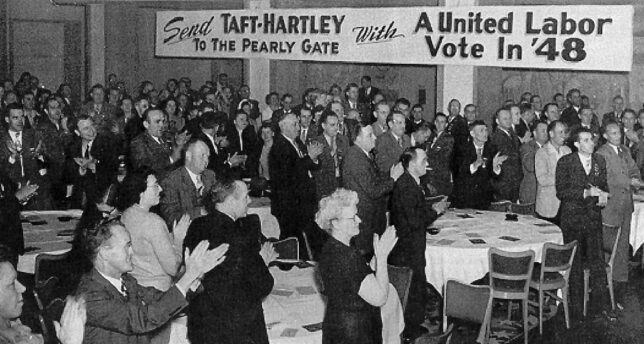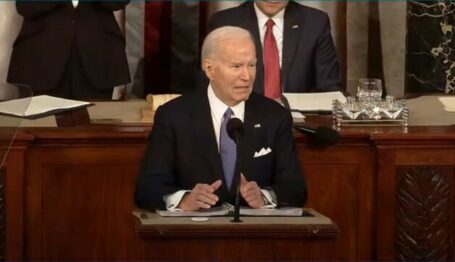Labor Watch
In Defense of Taft-Hartley: The Taft-Hartley Consensus
 Despite organized labor’s protests that the Taft-Hartley Bill was a “slave-labor law,” it made fundamentally modest changes to the Wagner Act regime. Credit: C.M. Lewis. License: https://bit.ly/44SEKAB.
Despite organized labor’s protests that the Taft-Hartley Bill was a “slave-labor law,” it made fundamentally modest changes to the Wagner Act regime. Credit: C.M. Lewis. License: https://bit.ly/44SEKAB.

In Defense of Taft-Hartley (full series)
Why Taft-Hartley Came to Be | The Taft-Hartley Consensus
Advancing Voluntarism | Protecting the Public
Laying Out the Taft-Hartley Consensus
Before analyzing the Taft-Hartley Act and the right-of-center policy consensus it promoted, it is important to specify what the act—and the policy consensus—did not do. Despite organized labor’s protests that the bill was a “slave-labor law,” it made fundamentally modest changes to the Wagner Act regime. These changes were so modest that the National Right to Work Committee’s official history would later argue that the legislation that made states’ powers to pass right-to-work laws explicit “did little to rectify the fundamental wrongs of federal labor law [that is, the Wagner Act].”
Taft-Hartley accepted as fait accompli the Wagner Act’s framework of compulsory, monopoly-union bargaining. It also accepted as fait accompli numerous restrictions on employers’ conduct related to employee organization, including restrictions on employers’ general speech, property, and contract rights. The legislation subjected the liberal regime of the Wagner Act to conservative constraint and supervision—no more, no less.
Those constraints would form the Taft-Hartley conservative consensus principles. The most prominent of them is voluntarism in union membership and activities: a right-to-work law that forbids conditioning employment on the payment of union dues or fees enacts this principle. Other policies and legal doctrines have advanced voluntarism as well.
Also notable is subjecting union operations to government scrutiny and regulation. While this power seems statist on its face, it is a response to the extraordinary powers relative to free private associations that the Wagner Act granted organized labor and that the Taft-Hartley Act accepted as faits accomplis. Since the government has granted unions extensive powers to command both members and nonmembers alike, the government subjects union finances to extensive disclosure. Since the government has granted unions extensive protections from other general rules that apply to private associations, the government exercises power to regulate lawful union aims and to regulate unions’ internal procedures. The extensive corruption in the labor movement that grew alongside unions’ power and was exposed in the 1950s led to further lawmaking to regulate union affairs, most notably the federal Labor Management Reporting and Disclosure Act of 1959 (LMRDA).
The third prong of the Taft-Hartley conservative consensus derives from the political-economic source of the law itself: protecting the public from labor-dispute fallout brought about by union activities. In this way the consensus seeks the ostensible goal of pro-union legislation: “Labor peace,” an end to the Pinkertons-versus-Wobblies riots and violence of the late 19th and early 20th century and the creation of an orderly framework for labor-dispute resolution. Taft-Hartley (and the LMRDA) promoted protecting the public by placing limits on the aims for which labor unions could strike, specifically banning the “secondary boycott.” And it made the obligations of management to bargain in good faith with labor unions also apply to unions.
Taken together, these consensus aims have advanced substantially since 1947. Union voluntarism has advanced with 26 states (and the territory of Guam) enacting right-to-work laws. The Supreme Court’s Janus v. AFSCME decision made all government employment functionally right-to-work. Other Supreme Court decisions—perhaps most notably Communications Workers of America v. Beck, which held that a union contract could not compel a non-union-member to pay the portion of dues used for purposes other than representation—have constrained unions’ ability to compel payments as a condition of employment. Further, much to the chagrin of democratic socialists and purportedly conservative statists alike, millions of American workers have opted out of unionism by voluntarily choosing not to join or form unions, sending union density plummeting since its 1950s peak. (Union density is the proportion of workers who are either union members or working subject to union contracts.)
LMRDA, enacted to respond to the revelations of Jimmy Hoffa’s corruption by the U.S. Senate’s Rackets Committee, may not have rooted Mob corruption out of Big Labor by itself, but Taft-Hartley consensus Republican administrations employing aggressive law enforcement in the late 1980s and early 1990s substantially reduced Mob influence in labor unionism. The George W. Bush administration toughened the law’s disclosure requirements, and those requirements helped send a prominent former SEIU leader to prison in the late 2000s.
And strikes have become far less disruptive than they once were. While strikes and lockouts from the 1940s through the 1970s often took over 1 million Americans out of work, the 21st century has not yet seen a year with half a million idled and the attendant fallouts in the broader economy. The parade of horrors that President Truman condemned in 1946 are well in the rear-view mirror, in part thanks to legislation that Truman vetoed—a veto made, according to at least one recollection, as an act of unprincipled political opportunism.
The Taft-Hartley consensus has largely succeeded—succeeded so well in fact, that abandoning it from ignorance of the consequences of doing so seems possible. But the cynical reasoning to hold fast is simple: Organized labor is and has been the adversary of conservatism for a century and counting. The iron logic “reward friends, punish enemies” compels conservatives to continue the Taft-Hartley approach. This cynical reasoning is entirely correct. As I have argued at length, the ideology of social justice unionism that drives contemporary labor union activism demands that all factions of conservatives seek to constrain Big Labor.
But factional bean-counting is unsatisfying reasoning. Surely one ought to pursue ideal practical policies? Good news then: The Taft-Hartley approach still provides the best policy responses to the labor-relations challenges of the 21st century. Or at least responses superior to the European socialist imports of the “new right” factions or the coercive (if distinctly American) policies of the Biden administration and its allies in the palatial marble and concrete headquarters of national labor unions.
In the next installment, Conservatives have no good reason to abandon the principle of voluntarism.



